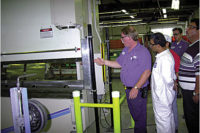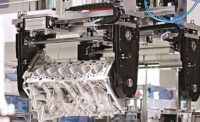Keeping workers safe is a daily challenge for every manufacturer, particularly those that operate one or more automated assembly lines. To achieve this goal, many companies make sure their machines are equipped with sensor-based safety components that meet ANSI, ISO, ISA and OSHA standards. These include light curtains, laser scanners, and safety controllers, encoders and interlock switches.
Light curtains help Robert Bosch GmbH improve worker safety and productivity at its mobility solutions plant in Toluca, Mexico. Made by Keyence Corp. of America, the GL-R series curtains are used around a machine that installs needle bearings into an engine shaft. Several assembly processes are also verified in the workstation that houses this machine.
Steve Nyerges, project manager in the total sensing solutions division at Keyence, says that reducing production-line cycle times was another reason why Bosch installed the light curtains in 2014. Cycle time went from 14 seconds down to 12.3, which increased output of the machine from 257 to 292 parts per hour.
“Previously, the machine’s physical guard took an additional 2 seconds to cycle,” explains Nyerges. “The operator had to wait until the door closed completely before starting the cycle. Now, the machine stops automatically when the curtain is interrupted by a person or object.”
CNC-lathe-operator safety is a big priority for power transmission manufacturer Tsubakimoto Chain Co. Shawn Martel, vice president and sales engineer at PowerSafe Automation (PSA), a systems integrator, says that PSA equips each lathe spindle with an encoder, a proximity sensor and a noncontact, door-interlock switch to optimize operator safety.
“Hard guarding and a handled door enclose the lathe,” notes Martel. “Before, when the worker opened the door, the spindle would spin for about 15 seconds before stopping. Today, simply standing too close to the lathe causes the proximity sensor to shut off the machine. Once the spindle stops, the door’s locking mechanism is released.”
This automatic machine shutdown protects workers from serious cuts as well as crushed, fractured, dislocated and amputated fingers and hands. Equally important, interlock switches and other safety products enable manufacturers to avoid costly OSHA fines, while maintaining normal machine operation. An added benefit is these technologies are easier than ever to implement and maintain.
Lights on, Danger off
Light curtains have significantly grown in popularity since being introduced in the 1950s as a technology for product detection. The curtains should only be used when one or all of the following conditions apply: The machine can consistently and immediately stop anywhere in its cycle or stroke; workers need to access the guarded area frequently; and physical guards would be an impediment. Suppliers say that light curtains should never be used on clutched machines or those that require a full revolution before shutting down.
Initially, light curtains used incandescent lamps strung together with a corresponding line of light detectors. Today’s light curtain is an elongated photoelectric sensor that consists of a transmitter and a receiver. The transmitter contains a series of LEDs that project an array of synchronized, parallel infrared light beams to the receiver. If an opaque object blocks any of the beams, the light curtain sends a stop signal to the guarded machine.
The GL-R Series Type 4 light curtain from Keyence features a 9-millimeter-wide recessed lens surface that completely guards the curtain from impact damage. It also features a 3-millimeter-thick extruded-aluminum body, one-line wiring system and quick-fit brackets. The wiring system allows the curtain’s transmitter to be connected directly to the receiver with a single cable, greatly reducing miswiring. Quick-fit brackets screw into the back channel of the curtain housing and attach to standard equipment framework without special protective hardware.
“Manufacturers in many industries use light curtains because they’re an effective replacement for hard guarding,” says Nyerges. “Light curtains are especially popular with automotive OEMs, and Tier 1s and Tier 2s that operate smaller machines, such as those for assembling fuel rods.”
Martel says that 90 to 95 percent of his company’s curtain-related installations are simple and require little downtime. Wiring is run directly from the curtains to a custom-built safety box for reliable signal communication between the transmitter and receiver.
The light curtain’s resolution—the smallest object it can sense—depends on what needs to be detected. A resolution of 12 to 14 millimeters is used to detect fingers, 30 millimeters is standard for hand detection, and 100 to 300 millimeters is used to detect people.
Last April, OMRON Automation and Safety introduced its F3SG-RR series of light curtains with an oil-resistant, IP67G-rated metal housing. The curtains are especially effective in work areas where CNC machining centers and other machines that use oil are operated, notes Matt Dodds, safety product marketing manager at OMRON. Up to three curtains can be series-connected in a cascade design to fit various protective heights and produce an array of up to 255 beams in the plane of detection.
Resolution is either 14 or 30 millimeters. The optical area on both models is completely covered with rubber to produce a leak-proof seal. Smartclick connectivity ensures a reliable connection and quickens installation. The installer simply inserts each M12 cable of the curtain into a mating connector, rotates it a 1/8 turn and hears a click.
Banner Engineering’s EZ-SCREEN LS curtains are specifically designed to safeguard various types of small assembly stations, says John Klesk, technical marketing manager at Banner. Bi-color alignment indicators built into the entire length of the receiver aid installers and maintenance workers. Green lights indicate the sensor is aligned properly and the receiver window is clean. The lights turn red when any area of the sensor is misaligned or the window is dirty. A thick aluminum housing, metal end caps and a recessed window prevent damage due to impact. Optional remote indicators allow the curtain status to be viewed from a distance to support productivity in a lean manufacturing environment.
Laser Scanners
The challenge of guarding large danger zones is best met with a safety laser scanner, which can be used in stationary or mobile applications. This type of scanner is an optoelectronic device that uses diffused reflection of emitted light to detect the intrusion of a person or object in a specified area, such as the interior of robotic workcells.
“Increasingly, manufacturers are installing safety laser scanners instead of safety mats for large guarding applications,” claims Jason Hitchcock, applications engineering manager at ATC Automation, an assembly automation and test systems integrator. “This is because the scanners are easily programmable, and more cost-effective and robust. Also, the mats take up valuable floor space and are susceptible to operator wear and damage from dropped parts.”
SICK makes the microScan3 laser scanner that uses safeHDDM (high definition distance measurement) technology to reduce the occurrence of false trips and related downtime. Tyler Glieden, national product manager at SICK, says that safeHDDM emits 80,000+ pulses per scan, which results in more available data for the scanner to evaluate. This data, combined with intelligent algorithms, allows the scanner to filter out dust, ambient light, weld sparks and dirt on the screen.
The scanner is compact, but offers a 5.5-meter scanning range and a 275-degree scanning angle for area and access guarding. It uses standard M12 connectivity and optional integration of CIP Safety over Ethernet/IP, and offers push-button diagnostics. According to Glieden, the scanner is used frequently by automotive manufacturers for robotic welding and assembly applications.
With an angular resolution of up to 0.071 degree, the R2000 series of detection scanners from Pepperl & Fuchs easily detects objects as small as 1 millimeter wide. The standard model avoids collisions with protruding parts on a stacker crane or a suspended conveyor system, while the high-density unit is designed for robotic tasks. Both models are capable of 360-degree scanning, but the latter scanner provides 84,000 scan points per second and an optimized angular resolution down to 0.043 degree.
Helge Hornis, technology director at Pepperl & Fuchs, says that Pulse Ranging Technology within the scanner provides precise measurements and short response times in various ambient and object conditions. After an operator sets parameters directly on the device, the scanner’s interactive display provides text, graphical and diagnostic information during operation.
The Keyence SZ-V safety scanner has a built-in camera that captures images and videos when an object or person enters the protected area. According to Nyerges, users of the scanner include manufacturers of large products, such as tires for agricultural machines. The scanner provides an 8.4-meter protection zone, a 26-meter warning zone and a 190-degree field of view.
Network communication through Profinet, PROFIsafe, Ethernet/IP or UDP is possible. Other features include a detachable display, system memory plug and multi-zone monitoring.
Stay in Control
Both the SC26-2 and XS26-2 safety controllers from Banner are now able to send data to connected devices via the Profinet communication protocol. The configurable SC26-2 controller provides stop and start functions for machines with hazardous motion, while the XS26-2 supports up to eight expansion I/O modules.
Klesk says that users of the SC26-2 include several automotive OEMs and Tier 1s, medical device manufacturers, and food and beverage companies. Robotic applications include welding cells and palletizing equipment.
Both models can be configured with up to 256 virtual status outputs, which can be used to send nonsafety status signals to PLCs, indicator lights and similar devices. They also support virtual nonsafety inputs, including manual reset, on-off commands, mute enable and cancel off-delay.
The OMRON NX-SL5 series safety controller supports direct connectivity to any safety device using a CIP Safety over Ethernet/IP connection. It is compact, powerful and adapts easily to a wide range of applications involving safeguarding devices, local or remote I/O and industrial robots with a CIP safety connection. The unit’s modular design allows for scalable expansion, from a small system with a few I/O points, to large applications that require up to 2,032 points. Sysmac Studio software allows automatic programming based on an array of conditions. Online safety function verification logs workflow data for complete traceability.
Functional safety encoders generate information about position, angle, and revolution counts, with a particular emphasis on mechanical and electrical safety. The RVS58S series from Pepperl & Fuchs have a sine-cosine interface and are capable of 1,024 and 2,048 pulse counts. They are TÜV certified and usable in applications with a Safety Integrity Level up to 3, according to the IEC 61508 standard.
Hornis says that the encoders are frequently used to monitor motors in conveyor and material handling systems, scissor lifts and rolling presses. The encoders deliver a maximum output frequency of 200 kilohertz in operating temperatures from -20 to 80 C. They are rated to handle axial shaft loads of 40 newtons at 6,000 rpm or 10 newtons at 12,000 rpm; and radial shaft loads of 60 newtons at 6,000 rpm or 20 newtons at 12,000 rpm.







